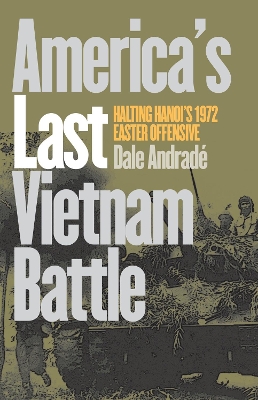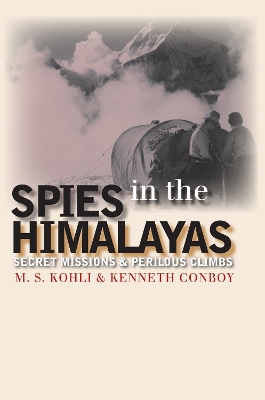Modern War Studies
5 total works
Time after time during the Vietnam War, the United States sent Vietnamese spies and commandos behind enemy lines only to have them killed, captured or compromised into reporting back false information. This is a sobering account of the disastrous secret programme, run first by the CIA and then by the Department of Defense. It aims to reveal a previously hidden side to a frustrating war and reclaims the lost lives of those who were sacrificed for so little gain.
In the spring of 1972, North Vietnam launched a massive military offensive designed to deliver the coup de grace to South Vietnam and its rapidly disengaging American ally. But an over-confident Hanoi misjudged its opponents who, led by American military advisers and backed by American airpower, were able to hold off the North's onslaught in what became the biggest battle of a very long war. This is the story of of heroism against great odds.
In the towering mountains of northern India, a chilling chapter was written in the history of international espionage. After the Chinese detonated their first nuclear test in 1964, America and India, which had just fought a border war with its northern neighbour, were both concerned. The CIA knew it needed more information on China's growing nuclear capability but had few ways of peeking behind the ""Bamboo Curtain"". Because of the extreme remoteness of Chinese testing grounds, conventional surveillance in this pre-satellite era was next to impossible. The solution to this intelligence dilemma was a joint American-Indian effort to plant a nuclear-powered sensing device on a high Himalayan peak in order to listen into China and monitor its missile launches. It was not a job that could be carried out by career spies, requiring instead the special skills possessed only by accomplished mountaineers. For this mission, cloaks and daggers were to be replaced by crampons and ice axes. This text chronicles the details of these death-defying expeditions sanctioned by US and Indian intelligence, telling the story of clandestine climbs and hair-raising exploits. Led by Indian mountaineer Mohan S. Kohli, conqueror of Everest, the mission was beset by hazardous climbs, weather delays, aborted attempts and even missing radioactive materials that may or may not still pose a contamination threat to Indian rivers. Kept under wraps for over a decade, these operations came to light in 1978 and have been long rumoured among mountaineers. ""Spies in the Himalayas"" provides an inside look at a CIA mission from participants who weren't agency employees, drawing on diaries from several of the climbers to offer impressions not usually recorded in covert operations. A host of photographs and maps puts readers on the slopes as the team attempts repeatedly to plant the sensor on a Himalayan summit.
For most Americans, Cambodia was a sideshow to the war in Vietnam, but by the time of the Vietnam invasion of Democratic Kampuchea in 1978 and the subsequent war, it had finally moved to centre stage. Kenneth Conboy chronicles the violence that plagued Cambodia from World War II until the end of the twentieth century and peels back the layers of secrecy that surrounded the CIA's covert assistance to anticommunist forces in Cambodia during that span.
Conboy's path-breaking study provides the first complete assessment of CIA ops in two key periods-during the Khmer Republic's existence (1970-1975), in support of American military action in Vietnam, and during the Reagan and first Bush presidencies (1981-1991), when the CIA challenged Soviet expansion by supporting exiled royalists, Republicans, and even former Communists trying to expel the Vietnamese from their country. Through interviews with dozens of CIA Cambodia veterans-as well as special forces officers from Singapore, Thailand, Malaysia, and Australia-he sheds new light on the contributions made by foreign intelligence services. Through information gleaned from the U.S. Defense Attache's Office in Phnom Penh, he offers a detailed look at the development of the Khmer Rouge military structure, while his use of Vietnamese-language histories released by the People's Army of Vietnam helps more fully illuminate the PAVN's participation in the Cambodian wars.
More than a simple expose of CIA activities, however, The Cambodian Wars is also an authoritative history of that country's struggles over half a century. Conboy examines Cambodia as kingdom, colony, republic, revolutionary state, and Vietnamese satellite, and offers fresh insight into the actions of key players-Norodom Sihanouk, Lon Nol, Sisowath Sirik Matak, Son Ngoc Thanh, and others-that will enlighten even those who think they know that country's history.
Three decades in the making, The Cambodian Wars tells a little known chapter in the Cold War in which non-communists pulled off a surprising victory. Featuring dozens of photos covering events from 1970 to the trial of Pol Pot in 1997, it is must reading for anyone interested in contemporary Southeast Asian history, CIA covert operations, and the Vietnam War.
Conboy's path-breaking study provides the first complete assessment of CIA ops in two key periods-during the Khmer Republic's existence (1970-1975), in support of American military action in Vietnam, and during the Reagan and first Bush presidencies (1981-1991), when the CIA challenged Soviet expansion by supporting exiled royalists, Republicans, and even former Communists trying to expel the Vietnamese from their country. Through interviews with dozens of CIA Cambodia veterans-as well as special forces officers from Singapore, Thailand, Malaysia, and Australia-he sheds new light on the contributions made by foreign intelligence services. Through information gleaned from the U.S. Defense Attache's Office in Phnom Penh, he offers a detailed look at the development of the Khmer Rouge military structure, while his use of Vietnamese-language histories released by the People's Army of Vietnam helps more fully illuminate the PAVN's participation in the Cambodian wars.
More than a simple expose of CIA activities, however, The Cambodian Wars is also an authoritative history of that country's struggles over half a century. Conboy examines Cambodia as kingdom, colony, republic, revolutionary state, and Vietnamese satellite, and offers fresh insight into the actions of key players-Norodom Sihanouk, Lon Nol, Sisowath Sirik Matak, Son Ngoc Thanh, and others-that will enlighten even those who think they know that country's history.
Three decades in the making, The Cambodian Wars tells a little known chapter in the Cold War in which non-communists pulled off a surprising victory. Featuring dozens of photos covering events from 1970 to the trial of Pol Pot in 1997, it is must reading for anyone interested in contemporary Southeast Asian history, CIA covert operations, and the Vietnam War.
Defiance against Chinese oppression has been a defining characteristic of Tibetan life since the 1950s, symbolized most visibly by the much revered Dalai Lama. But the story of Tibetan resistance weaves a far richer tapestry than may be imagined. This text looks at how America's Central Intelligence Agency encouraged Tibet's revolt against China - and eventually came to control its fledgling resistance movement. It provides an account of this little known agency enterprise. It takes readers from training camps in the Colorado Rockies to the scene of clandestine operations in the Himalayas, chronicling the agency's help in securing the Dalai Lama's safe passage to India and subsequent initiation of one of the most remote covert campaigns of the Cold War.




